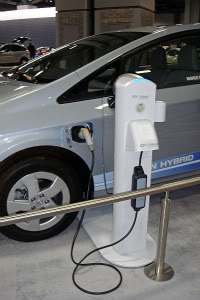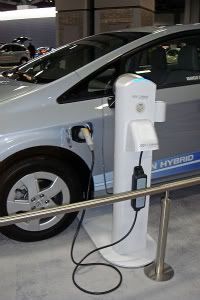Vehicle Electrification – by Guest Blogger Anil


Steven Chu, Secretary of the US Department of Energy (DOE) claims, “Plug-in hybrid electric vehicles could revolutionize personal transportation and cut our dependence on foreign oil, not to mention give us cleaner air and less carbon pollution.”
To say that federal and state support is crucial for this massive task will be an understatement. Even established automakers hesitate to take initiative on their own with government help. US federal government has initiated a number of stimulus programs including Advanced Technology Vehicles Manufacturing (ATVM) to encourage research in cleaner vehicles and fuels. The initiates are hailed by the automakers and suppliers alike. US government initiatives have resulted in Nissan expediting the launch of its LEAF electric vehicle in the US by at least two years, and has announced a truly attractive price: about $32,000, or $20,000 after federal and (most) state rebates. General Motors plans to launch its hybrid electric vehicle Volt by the end of next year. The company claims to have a 40-mile only electric range for the vehicle, enough for 90 percent of Americans to commute daily.
Healthy hybrid vehicles sales of Toyota Prius and Honda Insight have prompted skeptics to rethink their strategy towards electric powertrains.
Apart from doing brisk business in US, the hybrids have outsold traditional gasoline vehicles in Japan. As of late 2009, Toyota Prius had a 11.2% share in the Japanese automotive market. The vehicle has been bestseller in Japan since the launch of its third generation in May 2009. Hybrid vehicles account for 14.1 percent market share in Japan. The US is lagging behind but wants to attain same market penetration. Today, despite the global economic issues currently faced by the automotive industry, emission legislation holds a stronger focus.
Hybrid and electric vehicles promise immense reduction in fuel consumption and carbon emissions, as pure electric vehicles have no gasoline engines and produce no emissions. However, there are some issues with the widespread deployment of electrified vehicles. The biggest challenge for automakers to overcome regarding fuel efficient hybrid and electric vehicles are the cost and range. Electrified vehicles haven’t yet come down on cost curve, and consumers may be concerned about the range limitations — a phenomenon commonly referred as “range anxiety.”
Experts point to the divided opinion among the automakers regarding the cleaner vehicles. After announcing major plans of introducing hybrids and electric vehicles, Chrysler has recently dumped the plan in favor of traditional gasoline vehicles. Vehicle electrification was one of the pitches of the Detroit based automaker to receive federal bailout money.
Not everything is positive with the alternative propulsion systems such as hybrids and pure electrics. In particular, the vehicles suffer from some technological drawbacks. The current generation of clean transport options relies heavily on battery technology, which hasn’t advanced much during the years to accommodate the energy efficiency requirements of new age vehicles. Traditional hybrids including Toyota Prius, Honda Insight and Ford Escape use Nickel Metal Hydride (NiMH) battery technology. While the battery chemistry is very mature and reliable, it has inherent limitations regarding the energy storage capacity. NiMH contains toxic materials posing serious threats to the environment. The batteries also contain rare earth metals which are sourced primarily from China. Promoting EVs has the potentiial to shift dependence from declining oil reserves to already rare commodities.
NiMH technology is good for traditional hybrids but when it comes for new age hybrids and electric vehicles, lithium-ion is the choice of automakers. Lithium-ion batteries have relatively higher energy and power density to serve as motive power source for cars. However, the technology requires extensive use of lithium, a light metal found in abundance but rare to extract in an economic and cost effective manner.
Lithium based batteries are widely used in consumer electronics including mobile handsets and laptops. Since the demand for consumer electronic goods is increasing, lithium demand is also increasing. Automotive batteries bigger in size will require much more lithium than a typical gadget, which in turn will spiral the demand of lithium. Seconds Eichi Maeyama, Mitsubishi’s General Manager, “The demand for lithium won’t double but increase by five times”. Around 50 percent of the global lithium reserves are concentrated in Bolivia, a South American country. Bolivia is not a very capital investment-friendly country, and the government is trying to nationalize the reserves with the aim of creating a monopoly on the lines of OPEC.
Electric vehicles, also called zero emission vehicles aren’t exactly emission free vehicles as they use electricity instead of fossil fuel. The electricity is generated by coal fired power plants. More electric vehicles will result in higher demand for electricity in turn driving carbon emissions at the electric utility’s end.
Despite the shortcomings, governments are promoting electrified transportation with a hope to reduce dependence on oil. The situation isn’t exactly rosy at the supplier’s end. Car battery market, once controlled by Panasonic and Sanyo is now getting crowded with a multitude of traditional and new players entering the market. Industrial conglomerates including GE, BASF and Continental have entered into battery manufacturing business directly or indirectly. Apart from setting up a Sodium Halide battery manufacturing facility in the US, GE has invested in a lithium-ion battery producer A123 Systems.
Chinese battery supplier BYD shot into prominence after billionaire investor Warren Buffett controlled Berkshire Hathaway bought 10 percent ownership in the company. BYD has also entered into an agreement with Volkswagen to develop hybrid vehicles based on lithium-ion batteries.
Besides established companies, many new firms have received grants from Department of Energy for manufacturing batteries in US. Experts claim many battery startups do not possess the required technical abilities and are set to go out of the business five years down the line. Hopefully, the industry will also have greater clarity about the most efficient and feasible technology.

Contradict with many policies of Obama but at least would favor his act to make steps in order to electrify the vehicles; China is emerging , Russia is going to rise again, to capture the oil reserves can create a great conflict between world powers so it is the right time to do some thing; to get rid of dependency upon oil rich nations.